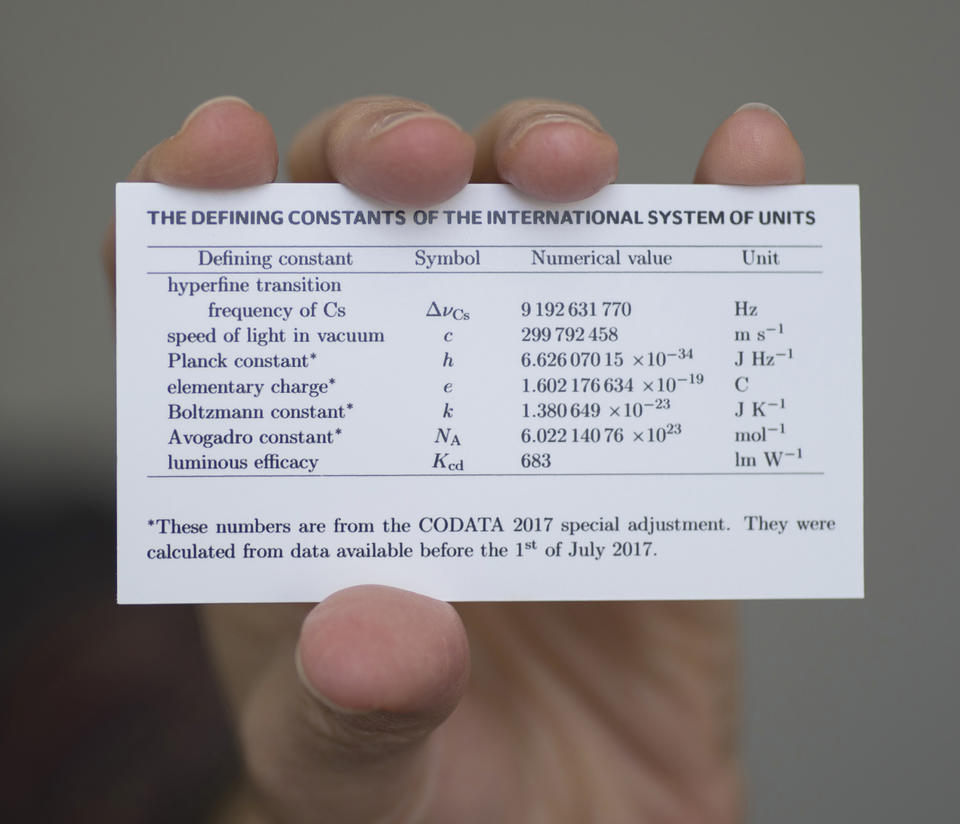Meet the Constants
The revised SI rests on a foundation of seven values, known as the constants. (SI is the acronym for the International System of Units, which is informally known as the metric system.) The values of the constants are the same everywhere in the universe. In the revised SI, these constants completely define the seven base SI units, from the second to the candela.
The below graphic shows the seven base SI units and the constants used to define them. Click on each of the SI units (outer boxes) to see which constants (inner boxes) define them.
c: the speed of light in vacuum
The speed limit in the universe is the speed of light in vacuum (empty space). Nothing in the cosmos—matter, information, energy—can travel faster than c.
c is equal to 299,792,458 meters per second.
In the revised SI, c helps to define the meter, kilogram and kelvin.
h: the Planck constant
The Planck constant is one of the fundamental constants of quantum mechanics. Quantum mechanics shows us that energy is exchanged and absorbed in specific amounts, known as “quanta.” h defines the size of those quanta, which can be visualized as packets of energy exchanged by matter.
In the revised SI, the Planck constant h is equal to exactly 6.626 070 15 × 10-34 Joule seconds. This value for the Planck constant was only finalized in 2017, and that value is key to redefining the kilogram.
h helps to define the kilogram, kelvin and candela.
e: elementary charge
e is the amount of charge in an electron. It’s connected to electromagnetism, one of the four forces of nature.
In the revised SI, e is equal to 1.602176634 × 10-19 coulombs.
It helps to define the ampere.
∆νCs: the hyperfine transition frequency of cesium-133
This might sound (and look) like sci-fi jargon, so let’s break this down a little bit. Cesium is a metal atom in the periodic table. Cesium-133 is its most common form, or isotope, containing a total of 133 protons and neutrons.
Like all atoms, cesium is orbited by electrons. The energy of cesium’s outermost electron can be controlled with microwave radiation. The frequency of microwave radiation that causes this electron to jump between two closely spaced low-energy states is known as the hyperfine transition frequency.
The hyperfine transition frequency ∆νCs is equal to 9,192,631,770 hertz.
In the revised SI, ∆νCs helps to define the second, meter, kilogram and ampere.
k: the Boltzmann constant
The Boltzmann constant relates an object’s energy to its temperature.
In the revised SI, the Boltzmann constant k equals 1.380649 × 10-23 joules/kelvin.
k will help to define the kelvin.

NA: the Avogadro constant
The Avogadro constant defines the number of particles in a mole, the SI unit that expresses the amount of substance. Simply put, Avogadro’s number of electrons equals one mole of electrons. Similarly, Avogadro’s number of water molecules equals one mole of water.
In the revised SI, NA equals 6.02214076 x 1023 particles per mole.
Kcd: the luminous efficacy of monochromatic radiation of frequency 540 × 1012 hertz
This last constant is arguably one of the most artificial and human-centered.
To explain it, let’s decode the entire second half of the definition first. “Monochromatic radiation of frequency 540 × 1012 hertz” is simply green light, specifically the shade of green light that the human eye can pick up most sensitively in a well-lit room.
And “luminous efficacy” is basically the total amount of visible light that a source produces using a certain amount of power.
Kcd is equal to 683 lumens per watt and helps to define the candela.


